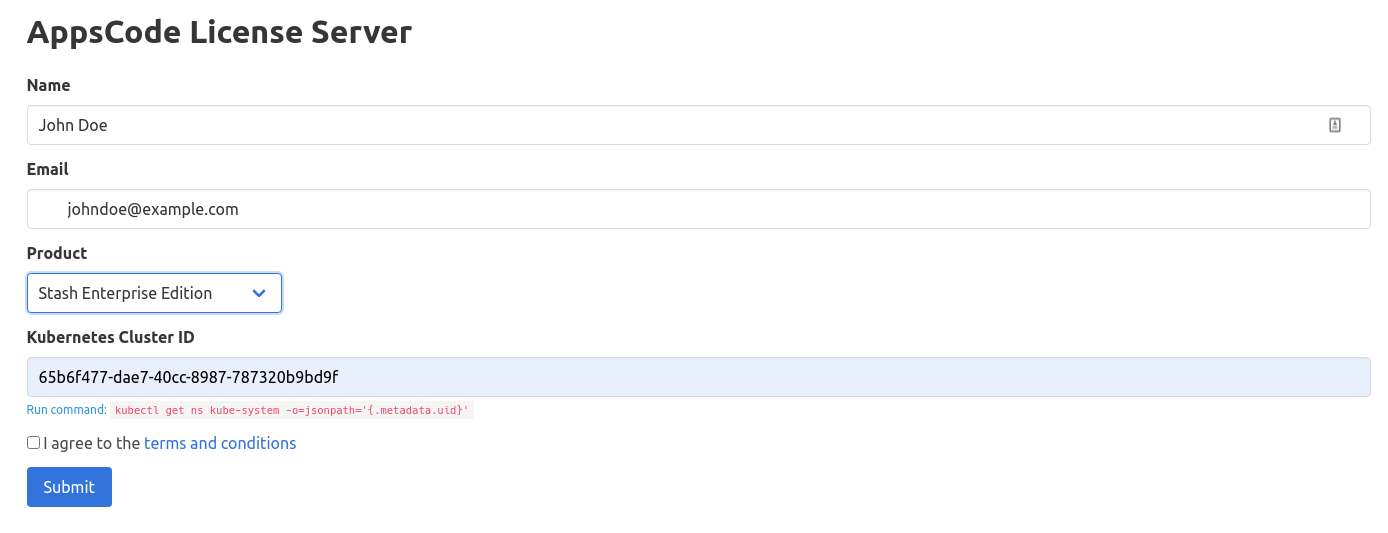You are looking at the documentation of a prior release. To read the documentation of the latest release, please
visit here.
Install Stash Enterprise Edition
Stash Enterprise edition is the open core version of Stash. It comes with all the functionalities of Stash Community edition as well as some advanced features such as Auto-Backup, Batch Backup, and Local Backend support, etc. A full features comparison between Stash Enterprise Edition and community version can be found here.
If you are willing to try Stash Enterprise Edition, you can grab a 30 days trial license from here.
Get a Trial License
In this section, we are going to show you how you can get a 30 days trial license for Stash Enterprise edition. You can get a license for your Kubernetes cluster by going through the following steps:
- At first, go to AppsCode License Server and fill up the form. It will ask for your Name, Email, the product you want to install, and your cluster ID (UID of the
kube-systemnamespace). - Provide your name and email address. You must provide your work email address.
- Then, select
Stash Enterprise Editionin the product field. - Now, provide your cluster ID. You can get your cluster ID easily by running the following command:
kubectl get ns kube-system -o=jsonpath='{.metadata.uid}'
- Then, you have to agree with the terms and conditions. We recommend reading it before checking the box.
- Now, you can submit the form. After you submit the form, the AppsCode License server will send an email to the provided email address with a link to your license file.
- Navigate to the provided link and save the license into a file. Here, we save the license to a
license.txtfile.
Here is a screenshot of the license form.

You can create licenses for as many clusters as you want. You can upgrade your license any time without re-installing Stash by following the upgrading guide from here.
Stash licensing process has been designed to work with CI/CD workflow. You can automatically obtain a license from your CI/CD pipeline by following the guide from here.
Get an Enterprise License
If you are interested in purchasing Enterprise license, please contact us via [email protected] for further discussion. You can also set up a meeting via our calendly link.
If you are willing to purchasing Enterprise license but need more time to test in your dev cluster, feel free to contact [email protected]. We will be happy to extend your trial period.
Install
Stash operator can be installed as a Helm chart or simply as Kubernetes manifests.
Using Helm 3
Stash can be installed via Helm using the chart from AppsCode Charts Repository. To install the chart with the release name stash:
$ helm repo add appscode https://charts.appscode.com/stable/
$ helm repo update
$ helm search repo appscode/stash --version v2021.04.12
NAME CHART VERSION APP VERSION DESCRIPTION
appscode/stash v2021.04.12 v2021.04.12 Stash by AppsCode - Backup your Kubernetes native applications
$ helm install stash appscode/stash \
--version v2021.04.12 \
--namespace kube-system \
--set features.enterprise=true \
--set-file global.license=/path/to/the/license.txt
To see the detailed configuration options, visit here.
Using Helm 2
Stash can be installed via Helm using the chart from AppsCode Charts Repository. To install the chart with the release name stash:
$ helm repo add appscode https://charts.appscode.com/stable/
$ helm repo update
$ helm search appscode/stash --version v2021.04.12
NAME CHART VERSION APP VERSION DESCRIPTION
appscode/stash v2021.04.12 v2021.04.12 Stash by AppsCode - Backup your Kubernetes native applications
$ helm install appscode/stash --name stash \
--version v2021.04.12 \
--namespace kube-system \
--set features.enterprise=true \
--set-file global.license=/path/to/the/license.txt
To see the detailed configuration options, visit here.
Using YAML
If you prefer to not use Helm, you can generate YAMLs from Stash chart and deploy using kubectl. Here we are going to show the prodecure using Helm 3.
$ helm repo add appscode https://charts.appscode.com/stable/
$ helm repo update
$ helm search repo appscode/stash --version v2021.04.12
NAME CHART VERSION APP VERSION DESCRIPTION
appscode/stash v2021.04.12 v2021.04.12 Stash by AppsCode - Backup your Kubernetes native applications
$ helm template stash appscode/stash \
--version v2021.04.12 \
--namespace kube-system \
--set features.enterprise=true \
--set global.skipCleaner=true \
--set-file global.license=/path/to/the/license.txt | kubectl apply -f -
To see the detailed configuration options, visit here.
Verify installation
To check if Stash operator pods have started, run the following command:
❯ kubectl get pods --all-namespaces -l app.kubernetes.io/name=stash-enterprise --watch
NAMESPACE NAME READY STATUS RESTARTS AGE
kube-system stash-stash-enterprise-678bcb6db4-267vk 2/2 Running 0 3m
Once the operator pod is running, you can cancel the above command by typing Ctrl+C.
Now, to confirm CRD groups have been registered by the operator, run the following command:
$ kubectl get crd -l app.kubernetes.io/name=stash
NAME CREATED AT
backupbatches.stash.appscode.com 2020-08-24T08:20:54Z
backupblueprints.stash.appscode.com 2020-08-24T08:20:55Z
backupconfigurations.stash.appscode.com 2020-08-24T08:20:54Z
backupsessions.stash.appscode.com 2020-08-24T08:20:55Z
functions.stash.appscode.com 2020-08-24T08:20:55Z
recoveries.stash.appscode.com 2020-08-24T08:20:54Z
repositories.stash.appscode.com 2020-08-24T08:20:54Z
restics.stash.appscode.com 2020-08-24T08:20:54Z
restorebatches.stash.appscode.com 2020-08-24T08:20:55Z
restoresessions.stash.appscode.com 2020-08-24T08:20:55Z
tasks.stash.appscode.com 2020-08-24T08:20:55Z
Verify Catalogs
Stash Enterprise edition automatically installs the necessary Addon catalogs for database backup. Verify that the Addon catalogs have been installed using the following command.
❯ kubectl get tasks.stash.appscode.com
NAME AGE
elasticsearch-backup-5.6.4 5m8s
elasticsearch-backup-6.2.4 5m8s
elasticsearch-backup-6.3.0 5m8s
elasticsearch-backup-6.4.0 5m8s
elasticsearch-backup-6.5.3 5m8s
elasticsearch-backup-6.8.0 5m8s
elasticsearch-backup-7.2.0 5m8s
elasticsearch-backup-7.3.2 5m8s
elasticsearch-restore-5.6.4 5m8s
elasticsearch-restore-6.2.4 5m8s
elasticsearch-restore-6.3.0 5m8s
elasticsearch-restore-6.4.0 5m8s
elasticsearch-restore-6.5.3 5m8s
elasticsearch-restore-6.8.0 5m8s
elasticsearch-restore-7.2.0 5m8s
elasticsearch-restore-7.3.2 5m8s
mariadb-backup-10.5.8 5m8s
mariadb-restore-10.5.8 5m8s
mongodb-backup-3.4.17 5m8s
mongodb-backup-3.4.22 5m8s
mongodb-backup-3.6.13 5m8s
mongodb-backup-4.0.11 5m8s
mongodb-backup-4.0.3 5m8s
mongodb-backup-4.1.13 5m8s
mongodb-backup-4.1.4 5m8s
mongodb-backup-4.1.7 5m8s
mongodb-backup-4.2.3 5m8s
mongodb-restore-3.4.17 5m8s
mongodb-restore-3.4.22 5m8s
mongodb-restore-3.6.13 5m8s
mongodb-restore-4.0.11 5m8s
mongodb-restore-4.0.3 5m8s
mongodb-restore-4.1.13 5m8s
mongodb-restore-4.1.4 5m8s
mongodb-restore-4.1.7 5m8s
mongodb-restore-4.2.3 5m8s
mysql-backup-5.7.25 5m8s
mysql-backup-8.0.14 5m8s
mysql-backup-8.0.21 5m8s
mysql-backup-8.0.3 5m8s
mysql-restore-5.7.25 5m8s
mysql-restore-8.0.14 5m8s
mysql-restore-8.0.21 5m8s
mysql-restore-8.0.3 5m8s
perconaxtradb-backup-5.7 5m8s
perconaxtradb-restore-5.7 5m8s
postgres-backup-10.14 5m8s
postgres-backup-11.9 5m8s
postgres-backup-12.4 5m8s
postgres-backup-13.1 5m8s
postgres-backup-9.6.19 5m8s
postgres-restore-10.14 5m8s
postgres-restore-11.9 5m8s
postgres-restore-12.4 5m8s
postgres-restore-13.1 5m8s
postgres-restore-9.6.19 5m8s
pvc-backup 5m2s
pvc-restore 5m2s
As you can see from the above output that Stash has created Task objects for each supported databases.
Now, you are ready to take your first backup using Stash.




















